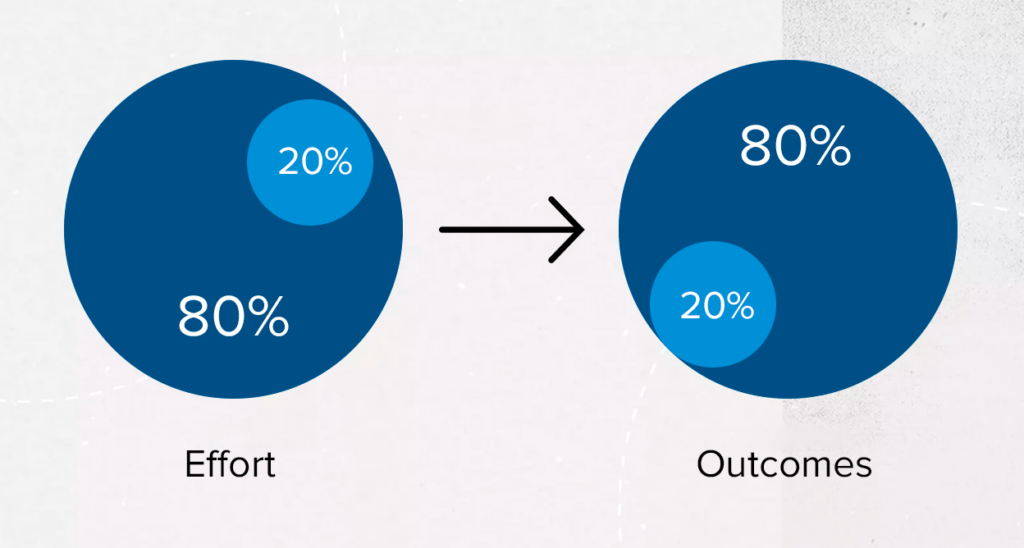The Pareto Principle (aka The 80/20 Rule)
- The Pareto Principle – What is it?
- Application
- Why you should use it
- Disadvantages
- How does Profile fit in?

What is the Pareto Principle?
The Pareto principle (also known as the 80/20 rule) states that roughly 80% of outcomes come from 20% of causes. Let’s talk about how you can use this principle to prioritize your tasks and business efforts.
When you start your work day each morning, what’s the first thing you do? Typically people grab a beverage, check their messages, and prioritize what they need to accomplish that day. But what techniques do you use to decide what needs to get done first?
Have you ever tried using the Pareto principle? This technique can help you determine and prioritize the tasks that will have the highest impact, increasing your productivity throughout the day.
The Pareto principle states that for many outcomes, about 80% of consequences result from 20% of causes. In other words, a small percentage of causes can make a big impact! This concept is important to understand because it can help you identify which tasks to prioritize to make the biggest impression on your day.
Italian economist Vilfredo Pareto developed The Pareto principle in 1896. Pareto noticed that 80% of the land in Italy was owned by only 20% of the population. He also saw this happening with plants in his garden—20% of his plants were bearing 80% of the fruit. This relationship is described mathematically as a power law distribution between two quantities – this means a change in one quantity results in a significant change in the other.
This phenomenon goes by a few different names:
- Pareto Principle
- The 80/20 rule
- Law of the Vital Few
- Principle of Factor Sparsity
As a note, the 80/20 rule is not a formal mathematical equation. It’s seen more as a generalized phenomenon that can be recognized in economics, business, time management, as well as sports.
Common examples that highlight the Pareto principle:
- 20% of a plant produces 80% of the fruit
- 80% of a company’s profits come from 20% of customers
- 20% of players result in 80% of points scored
Overwhelmed by your to-do list? Let Profile take over your 80%

Applying the 80/20 Rule
You can really apply this rule to any area of your life; however, it’s often used in business and economics since it’s used to maximize your output. For any work you have that can be segmented into smaller portions, the Pareto principle can help you identify what portions would be the most influential.
Productivity
You can use the 80/20 rule to prioritize tasks that need to get done during the day. Ideally, the goal would be completing 20% of those tasks will result in 80% of the impact on your day. So, to have the most impact, identify which tasks impact your team or others most, and focus on those first.
To put this in action list out all of the things that you need to get done that day. Then, identify which of those tasks will have the highest impact.
Questions to ask yourself:
- Do any of the tasks include working with other teammates?
- Are there any tasks that are blocking other projects from moving forward?
Sometimes these tasks could be simple to complete, but they can make a large impact on the rest of the team by allowing the process to continue moving forward.
The Pareto principle can help you during the problem-solving process too! If there are multiple causes of one problem, the Pareto principle can help you prioritize solutions. The following is an overview of how this looks:
- Identify the problems to which you’re trying to find a solution.
- Find and list the causes of the problems. (Use a tool like the “5 Whys” process to help get to all the causes)

- Sort your problems into similar groups. If some of the causes can fall into similar categories this might mean that one solution can resolve multiple issues.
- Rank these problems based on their impact on the business. You could number them from 1-10 or use monetary value to indicate their importance.
- Get a plan in place to focus on the top 20% of the problems that impact the business. The goal is to find solutions that can resolve multiple problems. Using the values assigned to each problem, calculate which ones are in the top 20%. Once you’ve nailed down the main problem, create a solution to achieve 80% of the results using problem-solving strategies.
Why Use It?
- Clear priorities for you and your team
- Increased daily productivity
- Ability to portion your work into manageable segments
- More focused strategy
The biggest advantage of using the Pareto principle is being able to obtain the maximum amount of impact with the least amount of work. This allows you to work more efficiently and stay focused on specific initiatives. Employing this rule can increase your metrics in less time, simply by prioritizing initiatives in the right order.
Disadvantages
A common misconception of the Pareto principle is that with 20% of effort, you can achieve 80% of the results. This is not the point of using it. The 20% and 80% numbers don’t relate to the amount of effort you’re putting in, but the cause and effect of what you’re working on. The goal is to focus your effort (not to minimize the amount of effort) to create a bigger impact. The mindset should be putting 100% of effort into that 20% of focus and in return achieving 80% of results.
Another thing to be aware of or watch for is sometimes you can get too focused and lose sight of other tasks. If you only focus on the important tasks and put aside the less important tasks, things can get lost. The challenge is finding the right balance of using the 80/20 rule, while still getting through the rest of your tasks!
How Can Profile Transaction Management Help?
Finding different ways to help your team achieve productivity is an important part of being a team leader. Using leverage like ProfileTM can help take hours of tasks off your plate.

